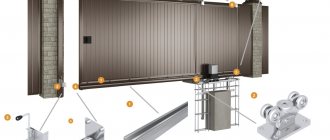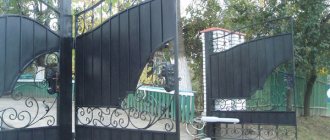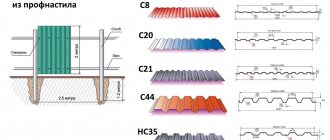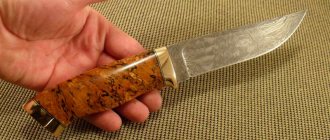Gate latch is a general name for a number of locking devices used by landowners to ensure basic security of access to the territory. Correctly installing a lock is a way to prevent intruders or simply strangers from entering the site whose visit is undesirable.
The term “valves” refers to a variety of devices purchased in a supermarket or at the construction market, special and cunning mechanisms that work on different principles. Although craftsmen often prefer to make gate valves with their own hands.
Requirements for locking devices
The latch must be reliable and convenient
When choosing the design of the gate closing mechanism, a number of general requirements are taken into account, as well as the type and material from which the door is made.
The device must provide:
- protection against opening by unauthorized persons during the absence of owners and at night;
- reliable fixation of the door leaf in any wind;
- uninterrupted operation in all weather conditions;
- rust resistance;
- ease of manufacture;
- ease of use (ergonomics) and safety;
- compatibility of appearance with the overall design of the fence and gate;
- manufacturability in manufacturing, installation and operation.
When determining the required type of locking device, the operating features must be taken into account. For example, for a gate from a patio to a garden (vegetable garden), there is no need for a tricky opening secret. The door to the street should open on both sides, and the lock should include a secret mechanism against intruders and random visitors.
Video on the topic “Simple gate clamp. clamp for gate"
Today there are a lot of options for deadbolts and locks. They all differ not only in appearance, but also in location, type of locking, and direction of movement of the main element. Among the main types it is worth noting the following:
- horizontal, divided into central, lower or upper. They are most often used for garage doors;
- vertical, having the same arrangement;
- additional ones, which are placed on the gate, doors of outbuildings.
All structures can be located on the frame of the doors or on the door leaf. The direction of the tongue can be oriented parallel or perpendicular.
According to the mechanism options, the most acceptable are:
Types of constipation and classification
The classification of locking devices and the requirements for them are determined by GOST 5089-2011 “Locks, latches, cylinder mechanisms. Technical conditions".
The document identifies three types of devices:
- Locks are products designed to lock protective structures and have security properties.
- Latches for fixing the door leaf in the closed position.
- Latches with a locking mechanism: products used to fix the door in the closed position, equipped with a locking mechanism.
Latches, in turn, are classified according to the following criteria:
- installation method: mortise or overhead;
- right, left, universal;
- single- and double-sided depending on the possibility of opening;
- principles of operation - mechanical, electromechanical, electronic, magnetic;
- deadbolt design - rectangular, with several bars of rectangular or round cross-section and with a beveled end (latch bolt).
Factory products are subject to certification tests, but homemade devices may not be inferior in quality.
Safe mechanism
Despite the formidable name, it is also not difficult to make. The principle of operation is similar to the previous one, but the constipations are combined into one. The fixed “fingers” are grabbed by hooks that are welded to the ends of a long rod. Locking occurs simultaneously at the top and bottom.
Advice that applies to any type of lock: two bolts (top and bottom) secure the doors much better than one in the middle. This is especially true for fence gates that do not have limiters at the top.
Main structural elements
In general, gate locks consist of several functional elements:
- housings;
- drive element (handles, keys) that unlocks/locks the door;
- an actuator that transmits movement from the key (handle) to the bolt or bolt;
- locking (reciprocal) plate - parts with a hole for the bolt to enter;
- a bolt that serves as a door lock when closed;
- leash, a part used to move the bolt.
With different versions, the composition of parts may vary.
When making a gate lock with your own hands, you must comply with all the requirements for locking devices.
Based on the design features and principle of operation, the following types of door locks are distinguished in everyday life:
- Latches are mechanical or semi-automatic devices. The working body is a metal plate with a lever-handle. When closing under the influence of a spring or gravity, the valve falls into the groove of the strike plate. To open, you must apply force to the lever and lift the locking plate or use the handle to remove the bolt from the groove. The latches can be self-latching or manually operated.
- Gate valves consist of a bolt with an attached handle. To close, you must slide a metal pin or plate into a groove, hence the name.
- Espagnolette, one of the types of lock with a round bolt rod that slides inside the body.
- A bolt is usually called a large-sized bolt designed for securing massive gates, gates, and garages. They are often equipped with return springs and grooves for fixing the working element in the closed position.
At home, latches, latches and spring bolts are made to lock gates. Each of these devices is most suitable for solving specific problems and has a number of advantages and disadvantages.
Gate valves by direction location
These types of latches will perfectly secure your gate, even your gate.
The horizontal type is most often installed. It consists of a rod, an ear for fixation and a holder.
Garage valve
The vertical version is usually used for gates.
But you can install it on a mortise gate. The size of the valves will be smaller than for gates. It is necessary to attach the clamps (by welding) to the latch mounting opening. The vertical type is more bulky than the horizontal type.
Making a homemade latch
There are several types of latches for home use, from simple rotary to automatic.
Rotary latch
It is convenient to lock from the inside using a simple device - a rotating hook or latch.
To make the device you will need a steel strip, self-tapping screws, bolts and nuts. From the tools prepare:
- grinder or hacksaw;
- drill with drills;
- hammer, pliers, vice;
- ruler, tap or pencil;
- welding machine.
For finishing, purchase a primer and paint for exterior use.
The simplest product consists of a deadbolt, a counter locking plate, an opening handle, and a limiter.
All parts are treated with anti-corrosion primer and painted before installation on the door.
Manufacturing algorithm:
- A bolt 15–20 cm long is cut from the steel strip.
- A hole is drilled in one side of the valve for the mounting bolt.
- The handle is welded or bolted for easy opening.
- Having drilled through the door leaf, the bolt is secured with a bolt and nut to the door leaf.
- A washer 2–3 mm thick is installed between the door and the hook so that the bolt does not rub against the door when moving.
- A counter plate is made from a steel strip by bending the part in a vice and drilling holes for fastening.
- Prepare the travel stop and attach it to the door leaf.
- Lubricate moving parts.
The simplest one-sided latch is ready for use.
In order for the device to be used, a hole is drilled in the door leaf on both sides and a handle is installed on the front side of the door. The handle can be removable. In this way, a secret lock is obtained, which only the owners or people privy to the secret can open.
Latch with padlock
By slightly complicating the design, you can get a reliable lock, but to open the gate you will have to open the lock.
To make a latch on a gate with a padlock, eyes are attached to the moving and fixed parts by welding.
Options and drawings are easy to find on the Internet.
Such a device can be used for a garden gate. Here the castle protects against random intruders or hooligans, and it does not protect against professional thieves.
Self-latching latch
You can make a latch for the gate that works automatically with your own hands. The operating algorithm of such devices is based on the spontaneous rotation of the bolt under the influence of gravity or a spring.
The simplest option consists of a bolt rotating in a vertical plane and a strike plate, the front part of which is cut at an angle.
When closing the door, the bolt slides along an inclined plane and at the end of the movement, under its own weight, lowers into the slot.
To open the gate, the bar is raised using a rotating handle made in the form of a ring or any other shape.
It is necessary to make self-latching bolts on the gate exclusively double-sided. Otherwise, if all residents leave the site, it will be impossible to open the door; you will have to climb over the fence.
Modern market of locking mechanisms
Progressive methods for developing reliable models of locks for gates and gates allow owners of suburban areas to purchase electromechanical and electromagnetic locks.
The reliability of the second type is explained by the supply of voltage force, which actuates the gate leaves. A magnet has the property of literally sticking to a metal surface, and it is in principle impossible to open it without using a set of special tools.
This kit is expensive, but, according to experts in this field, the costs are completely justified. The latest models are opened after confirming the fingerprint of the owner of the estate. It is impossible to make such a mechanism with your own hands without special skills.
Conventional gate latch design
Return to contents
Making a latch
Espagnols serve as additional protection of the site from the penetration of strangers at night or when all the owners are at home.
Espagnols close the gate on one side.
The simplest device consists of several parts:
- guide housing;
- bolt;
- strike plate;
- handles for manipulation;
- travel limiter.
The latch is made from available materials: a metal plate, a suitable piece of smooth reinforcement. For fastening you will need self-tapping screws, screws or bolts with nuts.
Work algorithm:
- Measure the distance between the gate leaf and the opposite post in order to cut the working element of the required length. The dimensions are chosen so that the bolt has sufficient travel reserve and overlaps the strike plate by at least 2 cm when closed.
- The parts of the latch are connected by welding.
- Weld the travel stop so that the valve parts do not fall out of the body.
- Paint the details.
- Mount the latch on the door.
The device is ready for use.
Double-sided latch
If the gate is made of a metal profile, the bolt can be hidden inside the crossbar. To do this, cut out the necessary holes in the pipe for the handle to move. The same slot is made in the corrugated sheet.
Finish the work by welding the handles inside and outside the gate.
The disadvantage is that the door will not be locked, thus the path to the site will be free for any person. At the same time, such locks reliably secure the gate from the influence of animals and wind.
The espagnolette can be locked with a padlock, for which eyes are welded onto it.
DIY spinner
A spinner is one of the most common options, and such a lock can be installed with your own hands. In order to make a lock of this type, you will need:
- Wooden beams are about 50 mm thick.
- Metal strips.
The essence of the work is the turning movement, with the help of which the beam locks the gate. It is mounted to the canvas thanks to a through bolt. Resting against the door block, the beam creates a tight fit. It is impossible to open them from the outside due to the lack of any mechanism.
The peculiarity of this latch is its simplicity and reliability. When installing a lock with your own hands, you may encounter the only problem - the presence of a small gap between the sashes. However, due to the design - the latch, which fits into the slide with a stop, it is not possible to open them. You can make such a lock yourself or go to a specialized store for a ready-made design.
Please note that using such a lock, you can create a convenient sliding system by welding a metal eyelet at the bottom of the sash. Thus, elements made of metal will allow you to reliably and with guaranteed safety lock the gate without fear of penetration from the outside
Spring deadbolt
The spring is needed to securely fix the valve in the closed position. If a massive gate or gate is exposed to strong winds, vibrations can gradually move the bolt to the open position.
It is not difficult to make a device yourself, using the factory design as a basis.
For work you will need a grinder, welding and a drill.
A spring holds the valve in the closed position. If it is necessary to open the door, pull the handle and overcome the resistance of the spring to move the bolt. To secure it in the open position, there are two petals at the end opposite the strike plate, through which the handle is pulled.
Options for locking, when springs act on a ball or cylinder for gates, are of little use - due to wind loads, the canvas will constantly move. Ball valves are used exclusively for interior doors.
Gate shutter made of corrugated sheets
It should be remembered that all mechanical deadbolts, unlike manual closing devices, require the presence of keys. Therefore, you don’t have to worry about losing them, since you can always lock the gate or gate using a manual mechanism.
In stock
There are several main types of such closing devices on sale:
- Vertical valves.
- Horizontal overhead valves.
- Screw valves.
- Overhead sliding locks.
- Rotary groove structures.
- Rack and pinion bolt mechanism.
- Mortise design.
- Latches with spring fastening.
- Code lock.
- Electromagnetic lock.
- Electromechanical lock.
On the counter
The latch for a gate made of corrugated sheets may differ in the direction of locking and the principle of operation of the mechanism.
Electromagnetic locks
If it is possible to supply a constant voltage of 12 volts to the gate, you can make an electromagnetic lock with your own hands. For this purpose, car door activators are used. It is important to clarify whether, when voltage is applied or removed, the activator moves the lock rod.
The device must be installed secretly under the wicket skin or in any housing to protect it from precipitation and icing.
Using unnecessary or the cheapest car alarms, they make locks with remote opening.
The electric magnet of the lock is activated when voltage is supplied from the control unit or operates from a hidden button.
The disadvantage of the design is the impossibility of latching - each time it is closed, it is necessary to activate the movement of the activator rod.
What types of gate locks are there?
There are a huge number of types of locks, which, in turn, are divided into subtypes.
For example, the latch can be mechanical (with a key) or manual. Additional manual installation is useful if the keys are lost.
According to the location of the direction, mounts are divided into horizontal and vertical.
Depending on how the mechanism itself works, they can be screw, sliding overhead, rotary with grooves, spring-mounted, crossbar, electric mechanisms (operating in automatic mode).
Previously, ordinary valves were the most common. Now a large number of other types of locks have appeared, which are actively used for various doors.
Good option for wooden fencing
When making a gate with your own hands, do not be too lazy to install a simple latch in the form of a turntable or latch.
Advantages
Some consider locks to be an outdated way of locking swing gates, gates, and doors.
Currently, stores have a large number of new locks, electric keys, CCTV and remote control systems. However, deadbolts have a number of advantages that determine their popularity today:
- reliability;
- ease of use;
- high quality material;
- low price;
- clear mechanism;
- opportunity to do it yourself.
Homemade option











